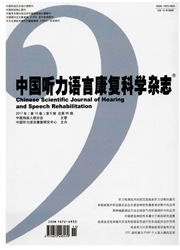

 中文摘要:
中文摘要:
目的观察缝隙连接蛋白30(connexin,Cx30)基因敲除纯合子Cx30(-/-)小鼠(P3、P7、P10、P30、P60、P90)耳蜗血管纹(stria vascularis,SV)超微结构的发育情况,进一步探讨GJB6基因突变导致耳聋的机制。方法选取Cx30(-/-)小鼠P3、P7、P10、P30、P60、P90等6个发育阶段的小鼠,用透射电镜观察耳蜗血管纹超微结构变化情况。结果P3~P90耳蜗血管纹边缘细胞、中间细胞、基底细胞呈现一个由不成熟至成熟的正常发育过程,至P90时均未发现退化性表现或缺失改变。血管纹毛细血管随着小鼠日龄的增加,管腔逐渐变宽,逐渐成熟,高倍镜下见P3、P7、P10时血管内皮细胞结构无明显异常,P30时内皮细胞之间的纤维突起出现疏松,P60时内皮细胞之间出现较大的裂隙,P90时这种改变更加严重,内皮细胞之间出现扩大的细胞间隙。结论 GJB6基因缺陷本身并不影响耳蜗组织血管纹的形态发育和成熟,GJB6缺失引起小鼠出生后逐渐出现的血管纹内皮细胞超微结构的改变导致内皮细胞屏障破坏,可能引起耳蜗内电位缺失,从而造成听力的下降。
 英文摘要:
英文摘要:
Objective To observe the ultrastructure of the stria vascularis(SV) of cochlear duct in connexin 30 knockout mice Cx30 (-/-) and to further explore the pathogenesis of deafness caused by GJB6 mutation. Methods Cx30 (-/-) homozygous mice at six time points after birth (P3, P7, P10, P30, P60, P90) were selected. The cochleae were dissected and observed under transmission electron microscope. Results The marginal cell, intermediate cell and basal cells of the SV developed normally from P3 to P90 in Cx30 (-/-) mice. No obvious cell degeneration or loss was found up to P90. The cavity of SV capillary became broader over time. The endothelium cells showed no obvious difference as compared with those of wild-type mice at postnatal ages P3, P7 and P10 under high-power lens. But at P30 intercellular connection between endothelium was loose and a gap occurred at P60. This change became more and more obvious and the enlarged intercellular spaces were found between these cells at P90. Conclusion GJB6 mutation may not hinder the development of marginal cell, intermediate cell and basal cells of the SV in cochlea. However, the changes of ultrastructure of SV endothelium may induce the damage of endothelial cell barrier and lead to the endocochlear potential and hearing loss.
 同期刊论文项目
同期刊论文项目
 同项目期刊论文
同项目期刊论文
 期刊信息
期刊信息
